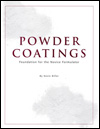Powder Coatings

The development of dry powder coating technology, around 30 years ago, was an important milestone for the coatings sector offering an environmentally benign application process that could deliver an excellent finish. Today, the use of powder coatings is widespread, particularly in the durable goods market, with the automotive industry providing excellent prospects for longer-term growth. The more recent development of powders with low cure temperatures that can be used on heat-sensitive substrates such as wood and plastic is extending the range of applications.
Consistent manufacture of powders with the required performance characteristics – at the right price – is a major concern, making effective process control an important goal. One of the defining parameters for a powder coating is particle size; this has a direct impact on the processability of the product and on the finish of the cured film. Tight control of particle size during production is therefore critical. In this article we examine the effect of particle size on product performance and the role that different particle size analysis regimes can play in optimizing powder coating production.
Optimizing Particle Size Distribution
Producing powder coatings with the desired properties requires an understanding of the effects of particle size and size distribution on handling properties, application and curing process, and the finished surface.
Fine
Particles
Fine particles can present difficulties in handling, and, in addition, an
excess of fines increases not only the respiratory hazard but also the risk of
explosion.
During application it can be more difficult to accurately direct fine particles. In electrostatic application systems, however, they tend to wrap around an item, usefully coating both sides. On the substrate surface, small particles will pack more closely together, reducing the severity of curing conditions needed to produce a smooth final coating. Fine particles may, however, be responsible for a poor surface finish – an orange peel effect – either as a result of melting too rapidly during curing or because charge build-up on the surface leads to ‘back-spray’ during application.
Large
Particles
Larger particles tend to flow well and can be
relatively easy to control during application. Their mass imparts a high degree
of straight-line inertia during spraying, which is particularly useful for
penetrating into the corners of an object. However, during curing, larger
particles take a relatively long time to melt, and melting may be incomplete.
This leads to inclusions in the final film, compromising both appearance and
mechanical integrity. Thus, curing times for larger particles tend to be more
severe in terms of both time and temperature.
Polydispersity
If a powder coating with a relatively large particle size has a broad size
distribution, then packing of the particles on the substrate surface is
improved as smaller particles fill the voids. This excludes air from the
coating, increasing overall thermal conductivity and the rate of melt formation
during curing. Consequently there is a high degree of crosslinking, which
enhances the mechanical properties of the finished coating. Where
polydispersity is low there will be a tendency to form inclusions in the final
coating unless the substrate is held at a high temperature long enough to allow
all the particles to flow together. With a finer product this problem does not
occur, and smooth films are produced using products with a narrow particle size
distribution.
The properties of the final film are to a significant extent controlled by manipulating particle size and size distribution. In general, powder coatings are produced in the size range 5-100 microns, although within the industry there is a long-term trend towards the smaller particles essential for producing the thinner films that are now in demand.
Optimizing Powder Coating Production
Powder coatings are made by mixing polymer with charge agents and other additives in a melt. This is then extruded to form chips or pellets that are subsequently ground to the required particle size in a series of steps involving milling or grinding and separation/classification. Powder coatings are manufactured in batches at facilities consisting of perhaps between 10 and 15 different lines, each producing a number of different products. Product changeover and process start-up are frequent events, and product contamination is a major issue; even one speck of, for example, a red product in a green batch can ruin a production run. The major goals for powder coating manufacturers are therefore to:- optimize product consistency;
- minimize product changeover times;
- avoid contamination; and
- minimize milling costs.
An at-line particle size analyzer integrates analysis with process operation, making it more responsive to plant needs and improving process control. For facilities with multiple lines it presents a viable option for improving control without the need to install a dedicated analyzer on every line. On-line measurement on the other hand provides a continuous stream of highly relevant data, permitting the development of optimal control strategies and the implementation of automated control. With a dedicated on-line system, operators can immediately see the results of their actions and can rapidly move the product to new specifications. Process understanding can be improved dramatically by systematically studying the effect of changing different variables. Operation can be optimized while product specification is maintained. The following examples illustrate the effect on mill control of moving to on-line analysis and its impact on process efficiency.

Mill Start-Up
Figure 1 shows a mill being started up under manual control with analysis taking place off-line, manually. The red circles show the times at which samples were taken, and the green circles indicate a change in mill parameters. The start-up procedure involves a series of iterative steps, each consisting of: a change to mill parameters; a period for the operation to steady itself following the change; sampling; and analysis. It takes around 50 minutes to bring the mill to the point where it is producing material with the required specification.Figure 2 shows the same start-up, still under manual control but this time with reference to data from an on-line particle size analyzer. Now the start-up takes seven minutes as the operator can immediately evaluate the effect of any change and quickly move to the required operating point. This time saving translates directly into a reduction in out-of-spec material and energy savings associated with a shorter batch production time. The change also increases mill throughput as it now operates productively for more of the time. In situations where mill start-up is a frequent occurrence these savings rapidly multiply into significant cost benefits.

Tighter Steady State Control
Milling is an energy-intensive process and, therefore, when it is used as a unit operation, manufacturers seek to minimize the extent of milling within the constraint of meeting the product specification. Overgrinding wastes energy, and where excess fines are an issue (as in powder coating), it drives the product out-of-specification. In the production of powder coatings, a tight specification is essential; mill operators must therefore control the process between two bands that define when the product has not been milled enough and when it has been over-milled. Figure 3 illustrates the tightening of mill control as a result of switching to on-line analysis.Initially the mill is under manual control and reliant upon off-line analytical data. Swings during operation are significant; the mill is operated far away from the actual specification in order to ensure that in between sampling times no out-of-specification material is produced. Once on-line data are available, mill control improves and fluctuations in performance become much less marked. With improved confidence in mill control, the operation changes so as to produce material that just meets the required specification. The result is a saving in overgrinding and a reduction in both waste produced and energy consumed.
This improvement in mill control can be used to narrow the bands that define acceptable mill operation, since staying between these bands becomes much easier. Not only does this lead to a more consistent product, it also minimizes the variable costs of milling.

Optimizing Analyzer Design
The potential benefits of both at- and on-line analysis are clear, however its full exploitation requires the selection of appropriate systems. The demands placed on an on-line instrument are particularly high. Analyzers must be reliable, industrially robust and compatible with existing units in the manufacturing facility in terms of, for instance, control software. Since one of the main aims is likely to be minimizing manual input, maintenance requirements must be low; analysis must be fully automated and data representation both effective and industry relevant. Systems that demand fiddly or complex manual intervention are prone to frequent breakdown, or present data inconsistent with industry sector norms; these systems will never be accepted or used properly, and the result will be a poor return on investment.For powder coating applications, two further issues, cleaning and sample presentation, also require careful attention during system design.
- Cleaning Because cross-contamination is such a significant issue for multi-product lines, instrument cleaning has to be easy and effective. There must be no dead spots in the design, and high-quality surface finishes are important to reduce product adherence. To enable thorough cleaning of the system between batches it must be easy to dismantle the instrument flow path parts, and the material of construction should be solvent-resistant.
- Sample presentation Powder coatings tend to have a low glass transition temperature. Energy-intensive sample dispersion is unnecessary and tends to encourage adhesion to the instrument wall with consequent clogging of the sample lines and blockage. To generate representative particle size distribution data, gentle dispersion of the sample will ensure that particles are transported to the measurement zone without the risk of agglomeration.
Conclusion
Effective and appropriate particle size analyses are essential for product development, process operation and quality control in the powder coatings industry. On-line analyzers that meet the requirements of the industry are the optimal choice for effective process control. They offer the potential for automated operation and the ability to make significant process efficiency gains. Well-designed, application-appropriate particle size analyzers have a vital role to play in helping manufacturers deliver products with the right performance/price characteristics, thereby helping powder coating technology to penetrate new markets.For further information, visit www.malvern.com, or email david.pugh@malvern.com.
Looking for a reprint of this article?
From high-res PDFs to custom plaques, order your copy today!





